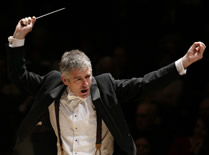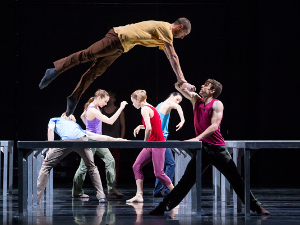Sound is fascinating, especially to composers and poets. To Rodney Waschka II, just about any sound can be transformed into music; the next logical step is to share it with an audience. On September 20, Professor Waschka presented the first Arts NOW! Series concert for this season in the Talley Student Center Ballroom at NC State University. All noted for their unique contributions to contemporary art, the featured composers were: Moonsoor Hosseini, Alden Jenks, Paul Lansky, Brad Garton, Andrew Milburn, Pauline Oliveros, Allen Strange, and Rodney Waschka II. The central theme was “language as a means of creating music.” There was also a hint of a preview for the 2012 John Cage Centennial. And there were two premieres: Alden Jenks’ Ognaggio al’Anzzonio (2003/11), an homage to his friend and colleague, Anthony Gnazzo, and the newly revised Cage in a Room (2009-11) by Swedish composer Monsoor Hosseini.
Alden Jenks’ Ognaggio al’Anzzonio, for performer and tape, borrows text from the composer and poet Anthony Gnazzo (along with a recording of his walking in “unusually squeaky shoes”). While manipulated and processed recorded materials play, an actor reads, at specified intervals of time, the very same words. The serious listener will hear qualities of sound that transform poetry into song. And with a twinkle in his eye, Waschka captures an element of spontaneity even while adhering to a carefully scripted score. It’s a wonderful piece!
Cage in a Room by Monsoor Hosseini, first performed by Waschka in 2009, brings to mind Alvin Lucier’s (1969) I’m Sitting in a Room. Aside from the use of language, the similarity ends here. Hosseini decomposes Cage’s text “I have nothing to say…,” ending with the “pop, pop, fizz, fizz” of seltzer tablets. The middle calls a one-man jazz percussionist to sputter out phonemes, each with distinct amplitude, duration, articulation, and pitch. Though Waschka’s directive, “it’s ok to laugh” worked for me in 2009, the context has evolved, making Cage’s words seem prophetic. The beauty, however, is not in the cosmetic trappings but the counterpoint, the essence and quality of every utterance. Poetry, in this way, is music. And despite Cage’s deterministic means of construction, Hosseini reveals meaning — and the makings of theater.
Pauline Oliveros, 2009 recipient of the William Schuman Award, is most noted for the concept we should all learn — “deep listening.” Waschka performed a fine example, The Witness (1979), a duet with imaginary partner (or as an ensemble with up to 100 performers). “Because”, said Waschka, “I had little experience as a child with an imaginary friend, I created my own electronic version.” Waschka and Waschka’s creation seemed to be derived from meditative chants — basic “ahs” and “ohms” and interesting vocalizations that mimic Mongolian throat singers. And like many of Oliveros’ works, this evening’s performance was like no other.
Some of the musical offerings were whimsical, fantastic, other worldly (Elemental Vamp, 1994 by Allen Strange; Wasting by Lansky, Garton and Milburn). Others were examples of man’s internal travels (Oliveros). All, including Waschka’s own work, share features of successful art — the ambiguity, the shape, the ordinary materials, magically transformed and very often layered, thus revealing, over time, more wonders — more questions — more feelings. That’s why A Short Letter from a Small Place remains a personal favorite, one of which I will never tire.












